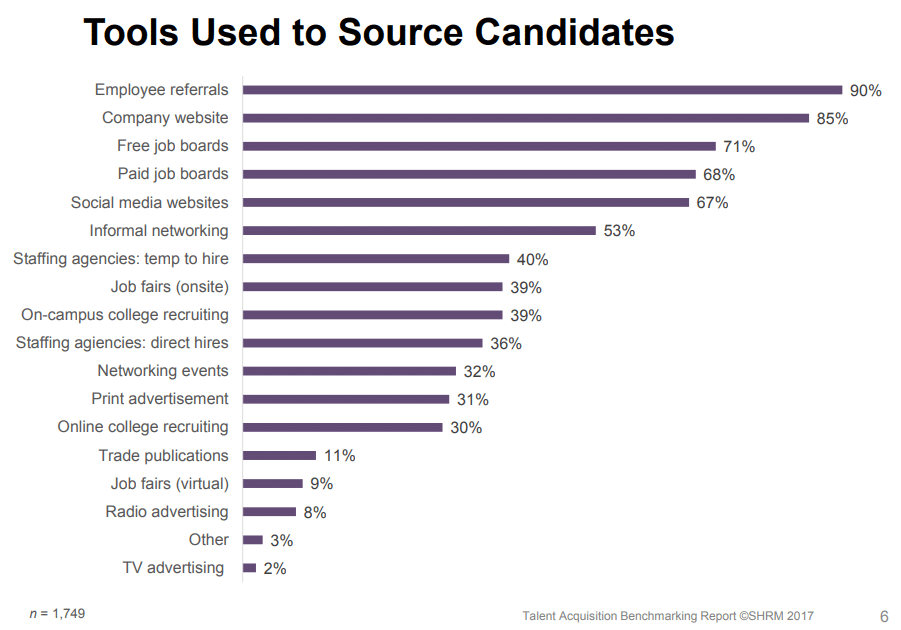They’re the job-hopping generation.
A recent report from Gallup found 6 in 10 millennials are open to new job opportunities; 21% of millennials switched jobs in the last year. That may not seem like much until you realize that’s 3x every other non-millennial group.
This looks downright disloyal.
The unfortunate part about all of this isn’t millennial job-hopping. It’s the fact that many employers today don’t know how to recruit and retain millennials, especially when it comes to B2B sales.
Who are these 'millennials,' and why do you need them?
Millennials consist of people born between 1981 and 1996; in recent years, they’ve been accused of destroying casual dining and the movie business, ruining homeownership and diamond sales. They’re even accused of killing mayonnaise! Some view them as persistent screw-ups who ruin everything.
Nothing could be further from the truth.
How do I know?
Millennials are the largest generation in the U.S. labor force, according to the U.S. Census Bureau. “More than one-in-three American labor force participants (35%) are Millennials. Millennials surpassed Gen Xers in 2016.” This glaring statistic is the reason why we need them.
Millennials understand each other.
Who cares?
If you’re like most sales managers looking to fill a B2B role, all you care about is whether your employees can sell effectively or not. Typically these managers don’t take the time to study job candidates, so you’re already ahead of the game.
What makes millennials so different?
· Millennials ignore advertising, and they hate ‘being sold to.’
· They’re focused more on experiences than they are on ‘ownership.’
· Millennials expect their work to have meaning.
· They want to learn and grow professionally.
Jim Clifton, Gallup Chairman and Chief Executive had this to say about millennials.
“Millennials will change the world decisively more than any other generation. Defined by their lack of attachment to institutions and traditions, millennials change jobs more often than other generations — more than half say they’re currently looking for a new job. Millennials are changing the very will of the world. So we, too, must change.”
He outlined several functional changes required to recruit and retain millennials in your organization.
1. Millennials don’t just work for a paycheck — they want purpose. They want to work for organizations with strong values, a mission, and an overall purpose. Compensation matters, but it’s not the main driver for millennials.
2. Millennials want professional development. They’re not interested in the typical command and control manager. They’re looking for a manager who’s akin to a coach. They want their manager to value them as people and employees; they expect their managers to work to understand them deeply.
3. Millennials want continuous feedback. Annual reviews aren’t compelling for these employees. They want a manager who’s willing to provide feedback on an as-needed basis, using the platforms they’re already familiar with — Slack, Skype, Twitter, texts, etc.
4. Millennials want to focus on their strengths. They don’t want to fix their weaknesses; Gallup data shows that strengths grow infinitely while weaknesses never really turn into strengths. This isn’t to say that it’s impossible; it’s simply not a priority for them.
5. Millennials view their job as a part of their life. They want a good job, one that’s fulfilling and fits with their values and cultural expectations. They’re asking themselves the question, “does this company give me the chance to do my best every day?”
What does this mean for your organization?
· Millennials are disrupting the way business is done. If you haven’t already, this means you’ll need to adapt the way you do business, so your organization is more appealing to millennials.
· You’ll need a sales team that understands millennial leaders in other organizations.
· Changing your people, process, and promotion structure is the key to successfully recruiting and retaining millennial superstars.
· Your compensation structure will need to: (a.) offer strong financial rewards to motivate employees (b.) provide ample opportunities for growth, development, and promotion.
· Employee marketing will need to be oriented around recruitment marketing and organic development channels.
This all sounds very vague, doesn’t it?
Let’s take a look at how we can make these strategies actionable and efficient for your organization.
How to recruit and retain millennials for B2B sales
You’ll need to lay the appropriate groundwork to attract employees.
What does this mean?
You’ll want to start with these three areas in your company before beginning your recruitment campaign.
1. Improve employee engagement
2. Recruit employees who are a culture-fit
3. Act with Authenticity, Communicate transparently
1. Improve employee engagement
Paul Warner, Ph.D., author of the book Magic: Five Keys to Unlock the Power of Employee Engagement, lists the five ingredients of employee engagement.
1. Meaning is in the eye of the beholder. There are a variety of details that give employees a sense of meaning and purpose. As people, we are driven by six basic needs. Meeting these needs provides your employees with the meaning and purpose they are seeking.
2. Autonomy refers to the freedom and control employees have while at work. Employees can have autonomy over their time, role, training, rights, or privileges. This implicit admission of trust creates ownership, stimulates passion and excitement, and increases motivation.
3. Growth: According to LinkedIn’s 2019 Workforce Learning Report, 94 percent of employees say they would stay at a company longer if it invested in their learning and development. Growth opportunities further increase employee drive and purpose and reduce their stress levels. The most obvious point? Growth opportunities increase your employee’s earning potential and advancement.
4. Impact is about outcomes and results. When employees achieve small wins or see that their work leads to positive results, they are willing to work harder. Impact leads to increased engagement and large productivity increases. The greater the impact, the greater an employee’s drive to produce.
5. Connection: A 2013 survey by Lifeboat found the average American only had one real friend. Employees today live in the age of loneliness. It’s terrible for employees, and it’s terrible for organizations. Loneliness decreases cognitive performance and immune health. Connected employees increase employee retention across the board.
Provide employees with each of these, and you have the tools you need to increase engagement on demand.
2. Focus exclusively on employees who are a culture-fit
What does this mean?
You’re focused on employees whose values and interests align with your company and the direction it’s taking. How do you do that? You outline your values and culture.
“Culture is living values.”
That’s not actionable; let’s change that.
Jeff Lawson of Twilio elaborates on this; Your values are written down and shared with everyone throughout the company. Your culture is how you live those written words.
Here’s the problem.
Most organizations attempt to do this from the top down — they tell their team to adopt a specific value set.
That doesn’t work.
If you want your organization to be appealing to everyone (including millennials), your values come from the inside out. This means you’ll need to take the time to talk to your current employees and gather intel and feedback. They need to know what you’re doing, why you’re doing it, and what the anticipated outcome will be.
At this point, you’re ready to go out and recruit millennials now that you’ve codified your values and culture.
How do you do it?
Bradford Smart, Ph.D., creator of Topgrading, provides simple ideas you can use to recruit all-stars.
First, you create a virtual bench.
Your virtual bench is simply a pool of A-player candidates, prospective employees-in-waiting who could be a good fit for your business. Creating a virtual bench is valuable for a few reasons.
· The virtual bench is passive. Your organization always has a pool of outstanding candidates to choose from at little or no cost. That’s significant when you realize that the average cost-per-hire is $4,129.
· When an opening is created, HR can choose from pre-screened employees who have gone through most hiring steps.
· You can find and hire A-players who are cheaper and better than “proven” candidates who have years of experience.
Your virtual bench is built from existing employees. Top performers spend time with other top performers. How do you motivate your existing employees to stay in touch with their A-player friends? You incentivize them! Here are two methods Dr. Smart recommends.
· Offer financial incentives. If a referred employee is still an employee after six months, you reward both the referred and referee with $1,000. This is a bargain as the average cost to hire a new employee is $4,129.
· Ask newly promoted managers to take an hour and list A-player subordinates in their most recent two jobs.
· Hire for potential rather than current competence. Fill your virtual bench with potentials who are a value and culture-fit. You can train competence; it’s much harder to address a culture mismatch.
· Acqui-hire. Hire A-players with A-players in their virtual bench. This requires that you confirm that you are indeed hiring an A-player.
These strategies ensure you attract eager and willing employees to be part of your employee advocacy program. Work to qualify prospective employees consistently, so you know they’re a culture-fit.
3. Act with authenticity, communicate transparently
What is authenticity exactly?
“The degree to which an individual’s actions are congruent with their beliefs and desires, despite external pressures.”
This sounds rare, doesn’t it?
Companies can’t display authenticity.
Instead, the people inside these companies, they display authenticity. Their behavior and actions then define their company. According to Edelman, trusted employers are leaders, especially when it comes to change. The top five communication topics that are most effective in increasing employer trust are:
1. Purpose: The organization’s mission and purpose in the marketplace.
2. Operations: Including company decisions that affect employee wellbeing.
3. Values: How do values drive the organization and define corporate culture.
4. The future: What is the organization’s vision for the future.
5. Societal impact: What are the organization’s contributions to the betterment of society.
Did you catch that?
These items are the same things millennials are already asking for. As it turns out, these details are the key to attracting A-player employees regardless of age. Your employees want to see that your company is going places; this data boosts employee engagement and improves retention.
Okay, you’ve laid the groundwork for incoming employees.
How do you recruit them?
It’s time for recruitment marketing. According to Jobvite:
“Recruitment marketing is the strategy and tactics used by an organization to source, manage, and nurture passive talent — before they apply to your job.”
Which channels should you use?
SHRM’s Talent Acquisition Benchmarking Report identifies the marketing channels used to source candidates.

Which one should you use?
Test all of them until you identify the channels that consistently produce the highest quality candidates (A-players who stay long term) at the lowest possible cost.
Then work to optimize these channels.
Create a concise recruitment marketing plan that recruits and retains A-player candidates.
1. Fix team dysfunctions and communication problems. Fixing these problems improves performance and productivity across the organization. This means rooting out silos and ending turf wars across departments.
2. Use reputation boosters, e.g., employee reviews via Glassdoor, individual and company awards, to improve employer branding. Work consistently towards building a strong company reputation. This is ongoing work that requires authenticity.
3. Improve candidate experiences. Don’t make the application process more difficult than it has to be.
4. Use lead nurturing to screen acceptable/unacceptable candidates; Spend most of your time with A-player candidates upfront. Use proven hiring methodologies like Topgrading to identify top performers.
5. Increase visibility across all sources/platforms. If you’re relying on job boards, make sure you’re visible for your target keywords and phrases.
These steps take a little bit of time.
They’re not complex or difficult, but they do require consistent effort and a team approach.
Not sure if your organization is fully on board?
Start with your department or a small team. Work to achieve quick wins, building momentum with each step; once you’ve achieved success, continue to expand until this becomes a company-wide initiative.
You can do this!
Recruiting millennials for B2B sales is simple
As it turns out, the golden handcuffs are pretty obvious.
Millennials are a product of our culture. They’re drawn to companies with a higher purpose, and they’re looking for managers who can coach them to success. If you’re an ideal employer, you’ll be viewed as an integral part of their lives.
6 in 10 millennials are open to new job opportunities; 21% of millennials switched jobs in the last year. Meet them where they are, serve them, offer consistent opportunities for success, and they’ll stay with you. Give them what they need, and Millennials will invest their blood, sweat, and tears into your organization.
In part two, we’ll take a closer look at how millennials approach job searches and the secret methodology you can use to recruit top performers.




